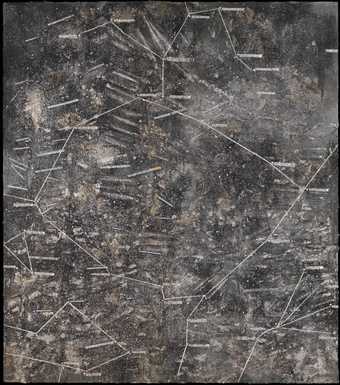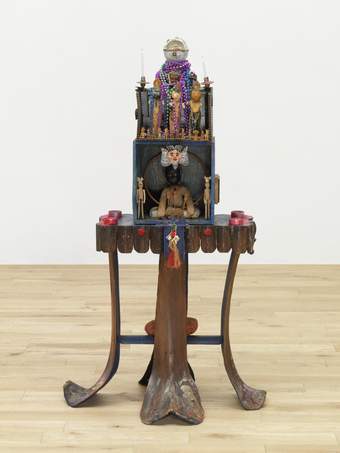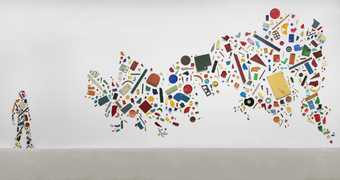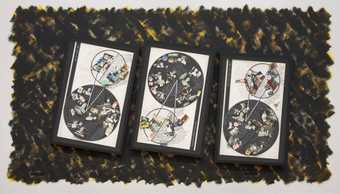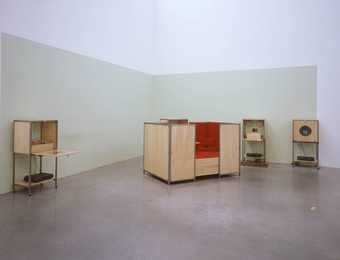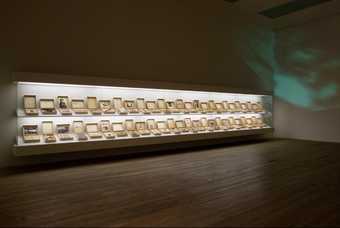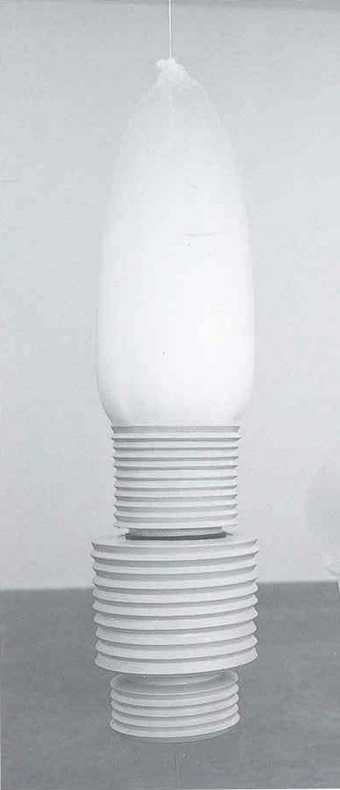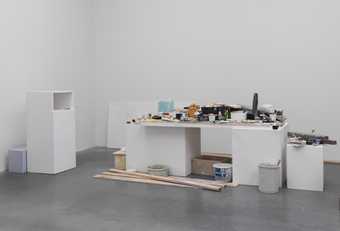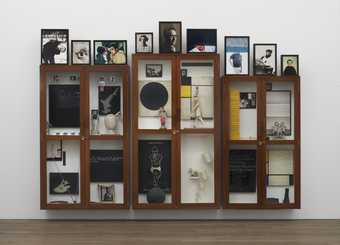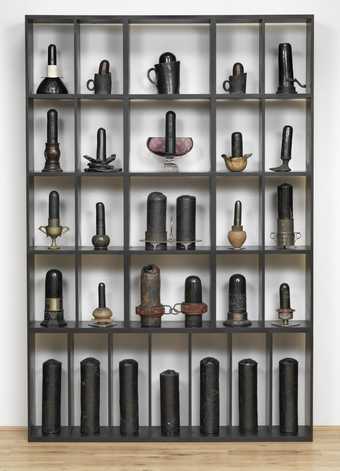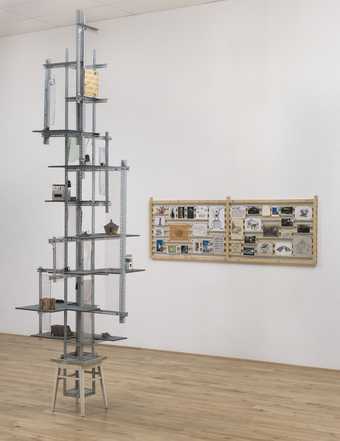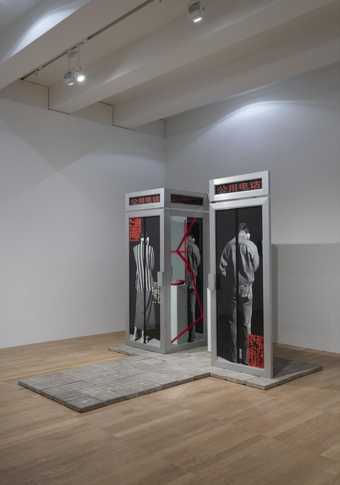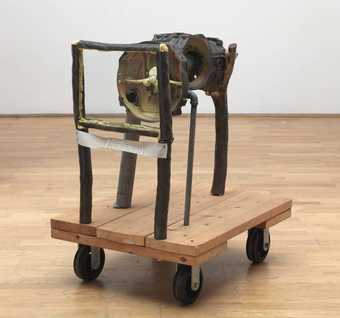
In Tate Modern
- Artist
- Jimmie Durham 1940 – 2021
- Medium
- Wooden box, bone, metal, wood, plastic, ink on paper, printed paper, fire hose, glass bottle, leather, branch, axe, lamp and other materials
- Dimensions
- Overall display dimensions variable
- Collection
- Tate
- Acquisition
- Purchased with funds provided by Tate International Council 2019
- Reference
- T15247
Summary
Untitled 1993–2012 is an installation comprising ten individual pieces that were originally presented at the 1993 Whitney Biennial in New York. Regarded as the ‘identity biennial’, this landmark exhibition was a crucial moment in American art that responded to the cultural politics of the time, provoking discourse and debate around multiculturalism and the lack of representation of artists of colour at museums. Durham’s contribution to the biennial consisted of a larger installation comprising this set of ten wall-mounted pieces, alongside three floor-bound sculptures, one of which is in Tate’s collection, entitled Dans plusieurs de ces forêts et de ces bois, il n’y avait pas seulement des villages souterrains groupés autours du terrier du chef mais il y avait encore de véritables hameaux de huttes basses cachés sous les arbres, et si nombreaux que parfois la forêt en était remplie. Souvent les fumées les trahissaient. Deux de... 1993 (Tate T13290), while the other two are lost. The ten wall elements were all part of the original presentation and hence are dated 1993. However, the text element of one of the parts had to be remade for the artist’s retrospective at MUHKA, Antwerp in 2012 and therefore this piece is dated 1993–2012.
Constructed from found objects and materials including metal gun parts, bullet shells, a fire hose, animal bones, glass lenses, tool handles and carved tree branches, the works are indicative of Durham’s assemblage techniques, though in a more simplified form. Each is accompanied by a handwritten text excerpted from major works of Western literature, including the Bible and works of Leo Tolstoy, Victor Hugo and Homer. The texts are written in English, German, Greek and Russian on scraps of paper and canvas that are casually pinned or attached to the object. Originally hung on an L-shaped wall, these pieces resemble crude, abstracted forms of weaponry and surveillance devices that collage manmade parts with natural materials. With characteristic wit and humour, Durham displays these instruments as clumsy, almost limp specimens. Critical of modern methods of violence and control, these works are as much a critique on Western systems of power, knowledge and domination, as they are poignant artefacts of everyday human life.
The works are indicative of Durham’s improvised process of making art. Taking elements produced in his studio in Mexico, Durham transported the works in a suitcase and completed the installation in New York, incorporating objects such as white PVC pipe found on the streets. In his words, in making this work he was inspired by:
Things that point. That was the first idea, and therefore the next thought was, ‘guns and cameras’. Almost all of the work was made in my studio in Cuernavaca, which was part of our house but with a separate door from the downstairs terrace. I do not collect garbage but material of any kind that seems useful and free so the studio was always full of stuff waiting to have new positions in the world … The finished work looked to me like a science fiction-type weapon as much as anything.
(Unpublished artist’s text on the ‘Making of the work for the ’93 Whitney Biennial’.)
Further reading
Anders Kreuger (ed.), Jimmie Durham: A Matter of Life and Death and Singing, exhibition catalogue, MUHKA, Antwerp 2012.
Anne Ellegood (ed.), Jimmie Durham: At the Center of the World, exhibition catalogue, Hammer Museum, Los Angeles 2017.
Clara Kim
July 2017
Does this text contain inaccurate information or language that you feel we should improve or change? We would like to hear from you.
Display caption
‘Things that point. That was the first idea, and therefore the next thought was, ‘guns and cameras’’, Durham recalled. This series of wall-mounted objects resemble crude weapons and surveillance devices, collaging industrial, crafted and natural materials. They are titled with texts from works of western literature including the Christian Bible, and works by Homer, Virgil, John Milton, Johann Wolfgang von Goethe, Leo Tolstoy and Thomas Mann. Durham confounds the relationship between object and text, subverting traditional museum practice and western systems of categorisation.
Gallery label, December 2020
Does this text contain inaccurate information or language that you feel we should improve or change? We would like to hear from you.
You might like
-
Anselm Kiefer Cette obscure clarté qui tombe des étoiles
1999 -
Betye Saar Mti
1973 -
Tony Cragg Britain Seen from the North
1981 -
Stephen Willats Are you Good Enough for the Cha Cha Cha?
1982 -
Andrea Zittel A-Z Comfort Unit with Special Comfort Features by Dave Stewart
1994–5 -
Susan Hiller From the Freud Museum
1991–6 -
Tomoko Takahashi Drawing Room
1998 -
Roger Hiorns Untitled
2003 -
Roger Hiorns Untitled
2005 -
Peter Fischli, David Weiss Untitled (Tate)
1992–2000 -
Atul Dodiya Meditation (with open eyes)
2011 -
Donald Locke Trophies of Empire
1972–4 -
Tamás Kaszás Shanty Tower
2014 -
Xiao Lu Dialogue
1989, remade 2015

